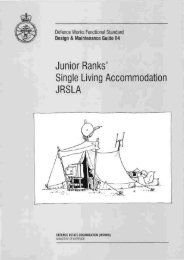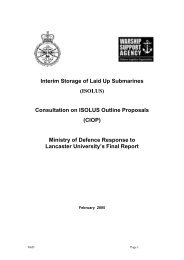Specification 49 Stone Mastic Asphalt for Airfields - Ministry of Defence
Specification 49 Stone Mastic Asphalt for Airfields - Ministry of Defence
Specification 49 Stone Mastic Asphalt for Airfields - Ministry of Defence
Create successful ePaper yourself
Turn your PDF publications into a flip-book with our unique Google optimized e-Paper software.
<strong>Specification</strong> <strong>49</strong> <strong>Stone</strong> <strong>Mastic</strong> <strong>Asphalt</strong> <strong>for</strong> <strong>Airfields</strong> 1 Introduction<br />
1 Introduction<br />
1.1 BACKGROUND<br />
1.1.1 The unique characteristics <strong>of</strong> military<br />
aircraft, in terms <strong>of</strong> speed, weight, tyre pressures,<br />
etc., create specialist requirements in the surfacing<br />
<strong>of</strong> MOD airfields. As such, specialist materials<br />
specifications are required to meet these needs.<br />
1.1.2 This Standard, <strong>for</strong> <strong>Stone</strong> <strong>Mastic</strong> <strong>Asphalt</strong><br />
(SMA), is one <strong>of</strong> a series being produced by DE to<br />
lay down specification requirements <strong>for</strong> airfield<br />
pavement works. The following clauses in this<br />
Section are intended to set out the applications <strong>of</strong><br />
SMA in the construction and refurbishment <strong>of</strong> MOD<br />
airfield pavements.<br />
1.1.3 The use <strong>of</strong> this Standard does not absolve<br />
a Project Manager from any responsibility <strong>for</strong> his<br />
designs, neither does its existence constrain him<br />
from using alternatives, provided such alternatives<br />
can be demonstrated to provide a result <strong>of</strong> equal<br />
quality.<br />
1.2 FUNCTIONAL REQUIREMENTS OF<br />
AIRFIELD PAVEMENTS<br />
The pavements must facilitate safe aircraft ground<br />
operations. In order to do this they must meet<br />
certain specialist per<strong>for</strong>mance requirements. The<br />
following sets out the main requirements, the<br />
relative importance <strong>of</strong> which will be dependent on<br />
the function <strong>of</strong> the pavements and the nature and<br />
type <strong>of</strong> aircraft operations:<br />
a. Good rideability.<br />
b. Good friction characteristics.<br />
c. High strengths and stability to withstand the<br />
shear stresses induced by heavy wheel loads<br />
and high tyre pressures.<br />
d. A durable, hard-wearing weatherpro<strong>of</strong> surface<br />
free from loose material and sharp edges which<br />
might endanger aircraft.<br />
e. Resistance to fuel spillage and jet blast.<br />
Depending on the nature and type <strong>of</strong> aircraft<br />
operations, these requirements are likely to be<br />
too onerous <strong>for</strong> asphalt surfacings in certain<br />
areas <strong>of</strong> the airfield.<br />
f. Facilitate economic maintenance.<br />
1.3 USE OF STONE MASTIC ASPHALT<br />
1.3.1 General<br />
SMA was developed in Germany over 30 years ago<br />
as a de<strong>for</strong>mation resistant material <strong>for</strong> use on<br />
highways. It is now widely used on highways in<br />
Europe and the USA. SMA was introduced as a<br />
surfacing material <strong>for</strong> airfields in the 1990s, notably<br />
in Norway. In the UK, there has been limited but<br />
significant use <strong>of</strong> SMA on airfields since the 1990s,<br />
including the resurfacing <strong>of</strong> two runways at a<br />
regional civil airport. Its first use on MOD airfields<br />
was limited to trial areas on the taxiways at RAF<br />
Lyneham (1997 and 2001) and RAF Wittering<br />
(1997). It has subsequently been used <strong>for</strong><br />
resurfacing MOD taxiways and also part <strong>of</strong> a<br />
primary MOD runway. The following guidance<br />
given on the application <strong>of</strong> this Standard is based<br />
on the experience gained from the early projects on<br />
MOD airfields together with the testing and<br />
evaluation <strong>of</strong> the trials carried out by TRL <strong>for</strong> the<br />
Construction Support Team / DE and highways<br />
experience.<br />
1.3.2 Main Length <strong>of</strong> Runways<br />
It is important on the main length <strong>of</strong> a runway to<br />
have good rideability and wet weather skid<br />
resistance. <strong>Asphalt</strong> surfacings generally give better<br />
rideability than PQC. Good skid resistance/friction<br />
characteristics are achieved by a combination <strong>of</strong><br />
good surface shape to effect efficient surface water<br />
run-<strong>of</strong>f and also surface texture to increase friction<br />
and allow water to disperse from under the tyre<br />
contact area. To meet these requirements, the<br />
most favoured option <strong>for</strong> MOD runways in the UK is<br />
the provision <strong>of</strong> a 20 mm thick Porous Friction<br />
Course on Marshall <strong>Asphalt</strong> surfacing. The<br />
alternative is grooved Marshall asphalt.<br />
Limited experience on an MOD runway indicates<br />
that good friction values can be achieved on SMA<br />
according to the test criteria in JSP 554 but that<br />
surface water drainage characteristics appear to be<br />
less efficient compared with Porous Friction Course<br />
and grooved Marshall <strong>Asphalt</strong>. Also, friction test<br />
results on SMA can be below the minimum<br />
requirements <strong>of</strong> JP 554 in the first few months <strong>of</strong> it<br />
being laid. Limited experience in Europe is similar.<br />
July 2008 1









